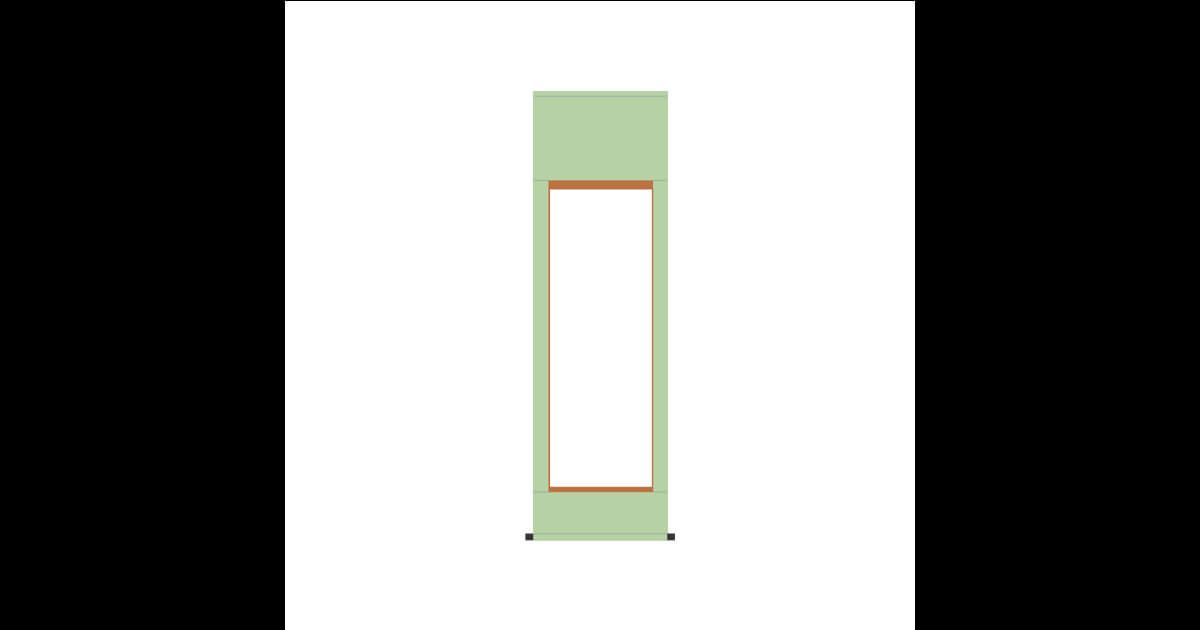Order from Germany: Remounting an Old Tiger Kakejiku Scroll
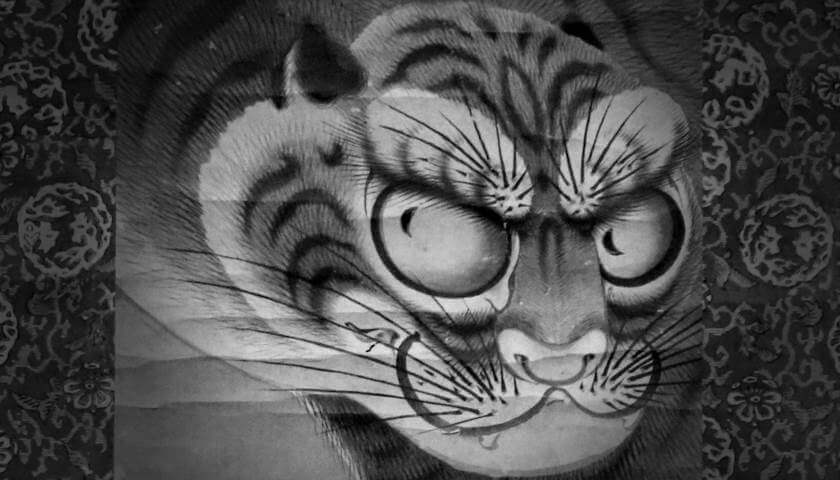
Contents
- 1 Inquiry from Germany
- 2 Arrival of the Tiger Scroll
- 3 Three Suggestions for Mounting Fabric
- 4 Remounting of the Nagasaki-school Tiger Hanging Scroll
- 5 Mekuri / Removal of Old Backing Paper
- 6 Urauchi / Backing, Karibari / Drying
- 7 Ore-fuse / Reinforcement
- 8 Hosai / Toning
- 9 Tsukemawashi, Kiritsugi / Cut and Join
- 10 The Second Backing
- 11 Tachiawase / Cutting to Size
- 12 Mimi-ori / Folding over the Edge
- 13 The Final Backing
- 14 Finishing
- 15 Remounting Completed! Here’s a New Hanging Scroll!
- 16 Client’s Voice
Inquiry from Germany
In June 2017, we received an inquiry from a German gentleman for remounting a hanging scroll. He is conducting an art gallery specialized on Japanese and East Asian Art. The gallery has a special focus on antique Japanese screen paintings (byôbû) and Japanese painted hanging scrolls (kakejiku) from the Edo period (1603-1868) and early modern times. It is a pleasure to meet people like him who have an in-depth knowledge of Japanese culture.
Here is a kakejiku that needs restoration.
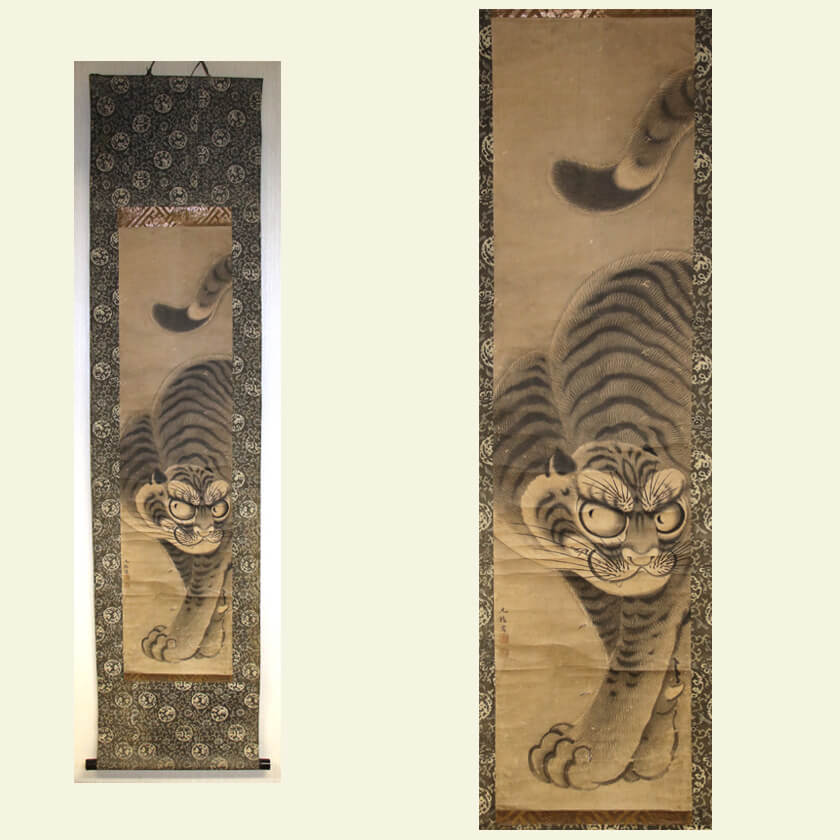
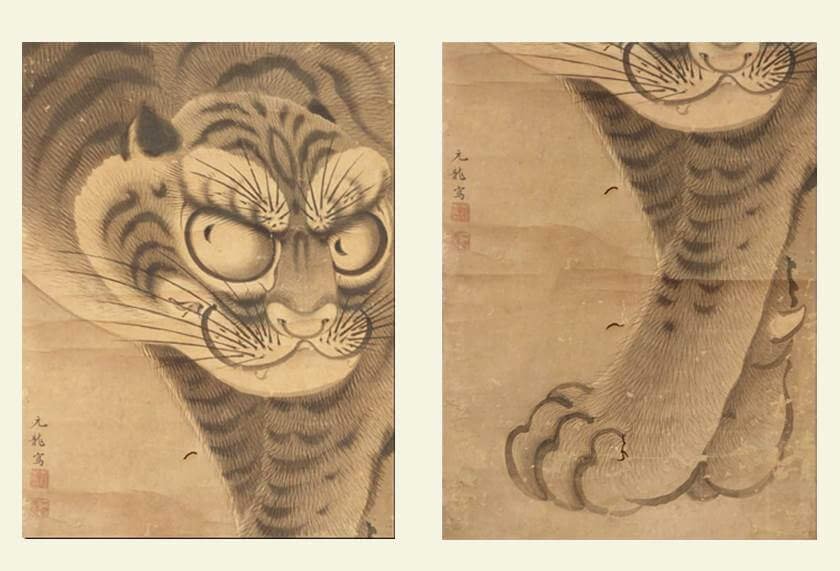

Thank you for the detailed pictures of the hanging scroll. We make an estimate on a per-project basis so all this information is helpful to check the scroll condition. According to the client, it is an 18th century Nagasaki-school painting of a tiger. Tigers are not native to Japan. It is said that the general public first saw the real tiger at the circus in the Meiji period. Until then, tiger was imaginary animal to most of Japanese. So, like the tiger in the above picture, the artists depicted it based on the idea of a cat, imagining what a tiger would look like. It is interesting that the description of tigers changes with the times.
For more info on Nagasaki-school, click:
The client’s requests were: to smooth countless wrinkles, repair moth holes and a tomobako. He also asked us if the scroll should have a futomaki or not.
We replied as follows :
- Wrinkles will be smoothed.
- Moth holes will become less noticeable by toning (hosai), which is the act of adding color to the lacking part.
- Tomobako stands for a box that already has a title and a name of an artist. What we can offer you is a plain paulownia box. Kindly let us know if it is acceptable for you.
- Regarding a futomaki, in my opinion, there is no need of a futomaki for this picture because the damage is not so severe now. However, if you wish for a better, lifelong preservation of the picture, it is a good idea to apply futomaki.
The client decided to have a plain paulownia wood box, not a futomaki this time. For more details, we shall talk after we receive the actual hanging scroll here at ART NOMURA.
Arrival of the Tiger Scroll

The scroll arrived successfully. Every time we open the package, we are always excited and thrilled since we can never judge the damage condition until we see the real one. Sometimes we find further damage or more details that we could not see from the pictures on the PC screen.
What we found this time was that the scroll had signs of having been remounted a few times in the past. Also, it had many damaged parts.
A Big Slit on the Face of a Tiger
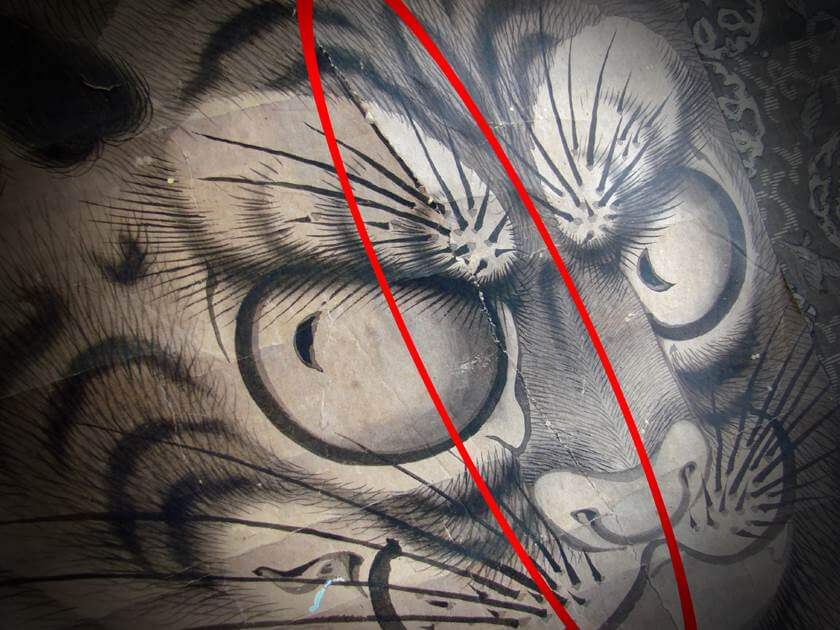
We found a big vertical slit on the tiger’s face. The slit was linked together so we can see the picture had been remounted before.
The scroll was attached a paper patch on the back (of the finished backing paper). It is an odd way to repair because it does not look good. Normally, a patch is applied directly to the back of a painting or the first(skin) backing.
Also, we were surprised to see the numbers and depth of creases from the back. The scroll had more severe damage than we first expected.

From the back of the scroll.
Countless Lacking Parts
It was obvious that the conservators did not do toning (hosai) in the former remounting so there were many missing/lacking parts throughout the picture. They were just covered by the backing paper, no signs of hosai.
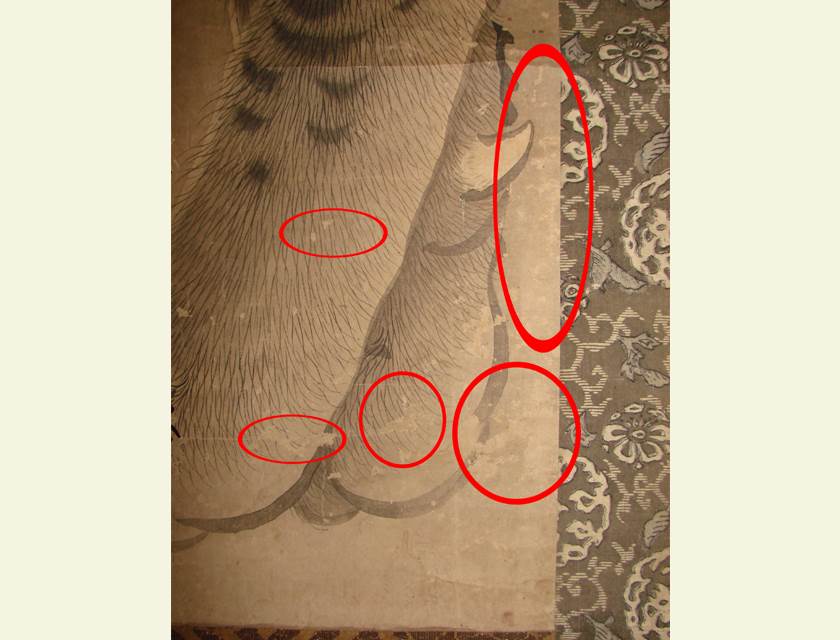
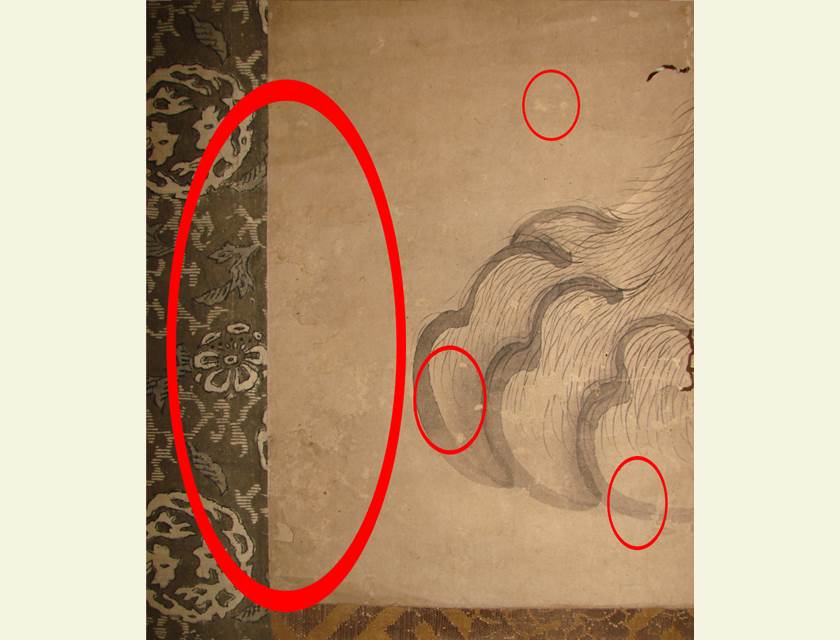
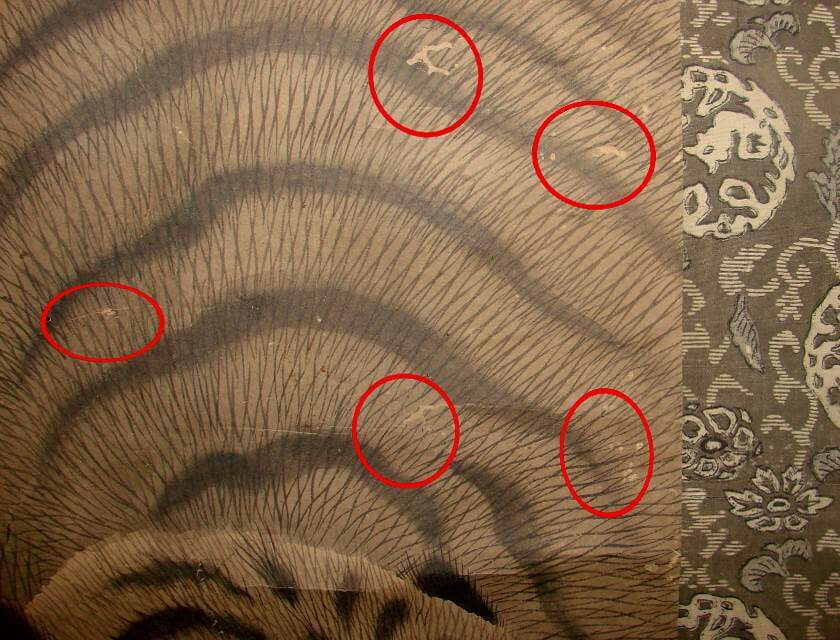
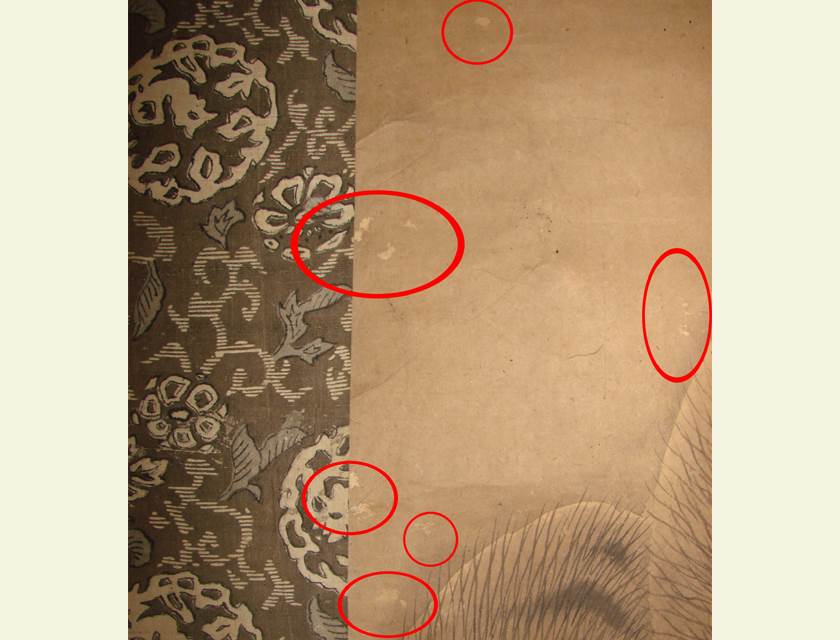
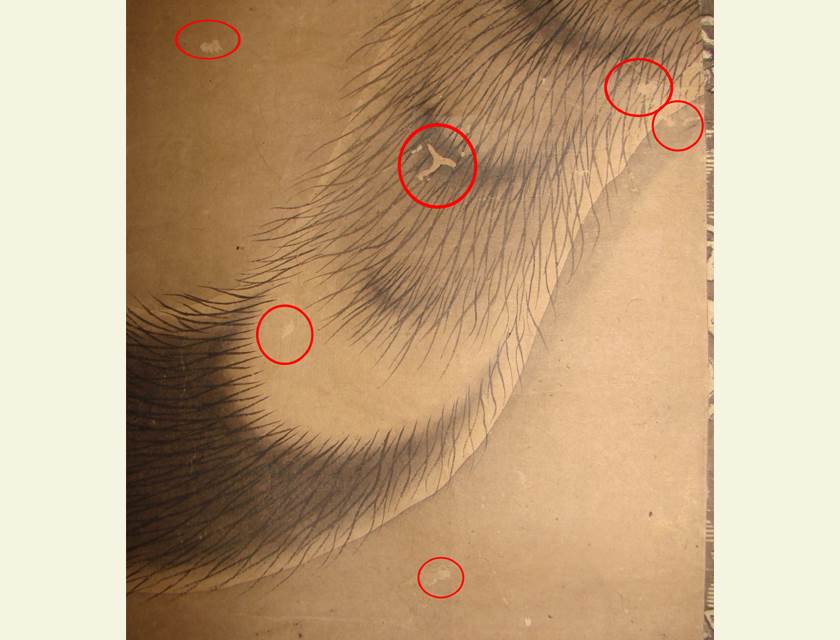

There’s a possibility that more flaking will occur during the remounting procedure since the picture is already vulnerable.
We explained the circumstances to the client and confirmed how he would like to proceed; to leave the lacking parts as it is or to repair all by toning (additional hosai) with additional charge. For his reference, we sent one example of toning (Please see below pictures.) and we also told what the cost would be for the repair.
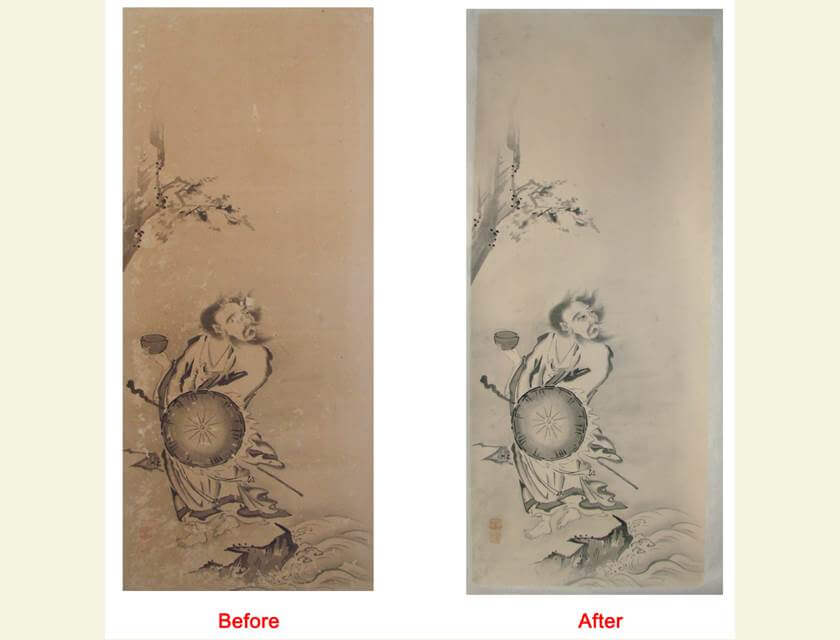
For a better finish, we highly recommend the additional hosai. To be frank, we wish to finish every work as beautiful as possible from the craftsman’s point of view. However, it needs additional charge and more time so we make sure to confirm and leave the final decision to each client. We were glad that the client kindly accepted our offer for additional hosai.
Three Suggestions for Mounting Fabric
We offered three suggestions for mounting fabrics with enlarged pictures as follows.

Pattern A
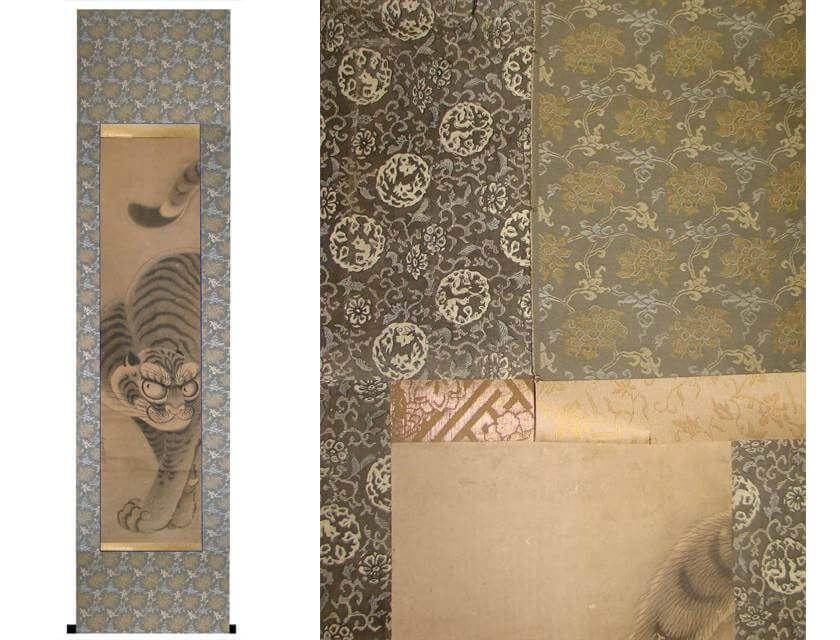
Pattern B
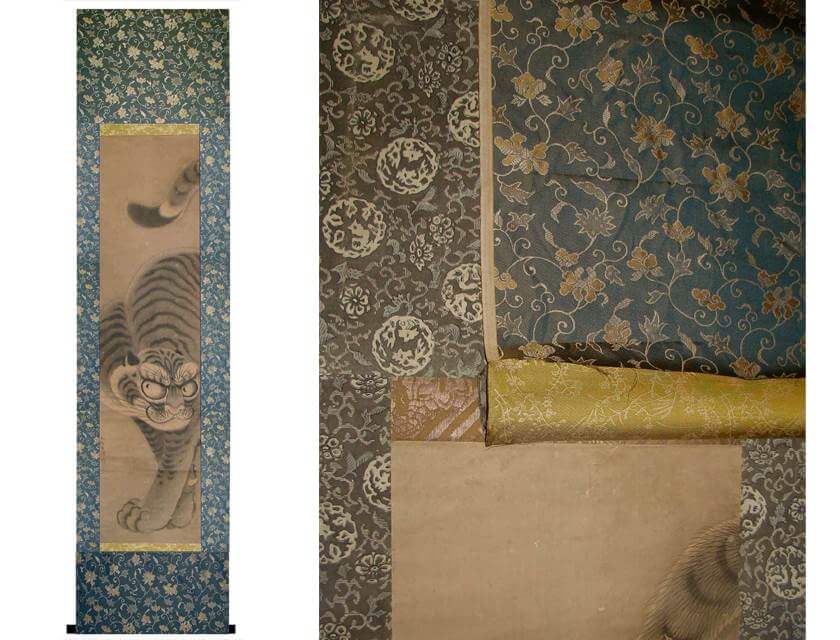
Pattern C
Out of these, the client preferred pattern B. However, he concerned about its fabric colours. The colour on the left picture (above) looks bluish while the colour on the right looks greenish (enlarged picture). He told us the greenish color framed harmoniously the soft tone of the paper and did not distract from the painting. On the left picture, the contrast does look a bit to hard, but he feels it is a computer graphic so the colors are not real.
Indeed! It is truly difficult to show the exact color of the fabrics. Therefore, we sent some more pictures with explanation to clear his concerns.
Regarding the outer fabric of sample B, please find some more pictures as per attached.
Please be advised that the color of fabric may appear differently depending on the type of light during photo shooting. Each type of light, including incandescent, fluorescent, and sunlight, may have a different effect on the appearance of the fabric’s color. Also, viewing the fabric from a slightly different angle can make its color appear brighter or darker.
The pictures (#1 to #4) were taken side by side with the actual artwork for comparison so it will help you imagine the real color easily. The fabric of sample B has a similar color like the original one. In my personal opinion, the fabric sample B looks like bluish, brownish, deep green color.
We have also taken some pictures under different types of light for your reference. Under natural sunlight, we see a little more brownish green while we see a little more bluish green under fluorescent light. Our overall impression is that it has a soft tone of deep green color.
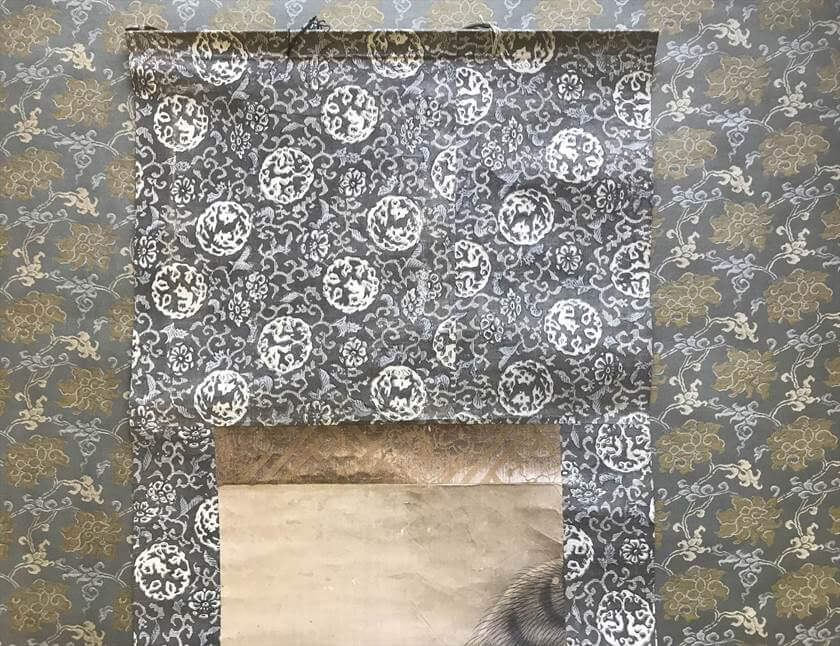
#1/ Front : Original Fabric | Back : New fabric of Pattern B
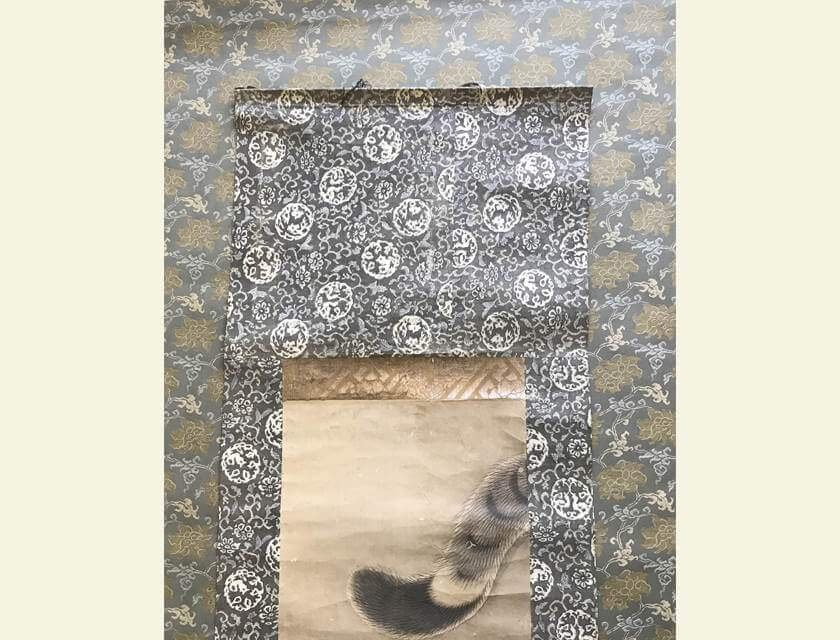
#2
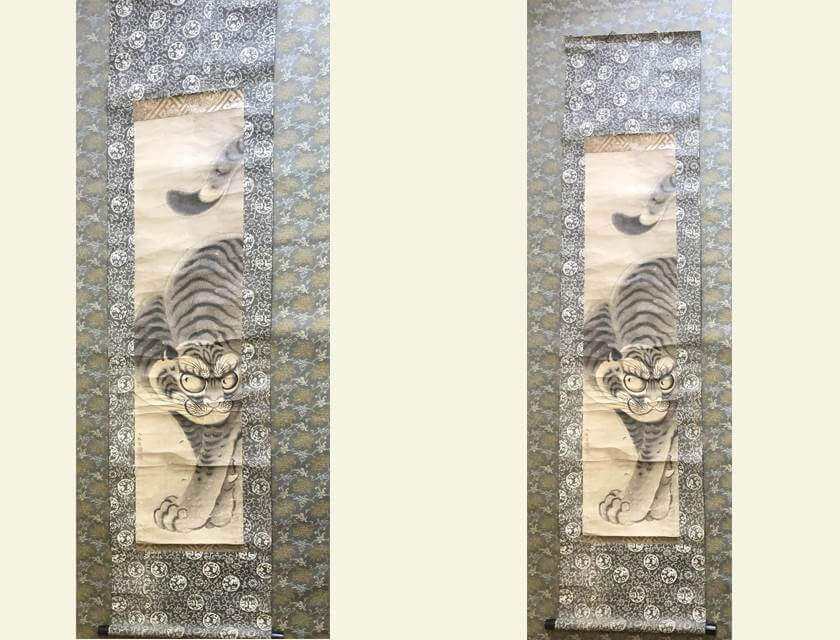
#3,4
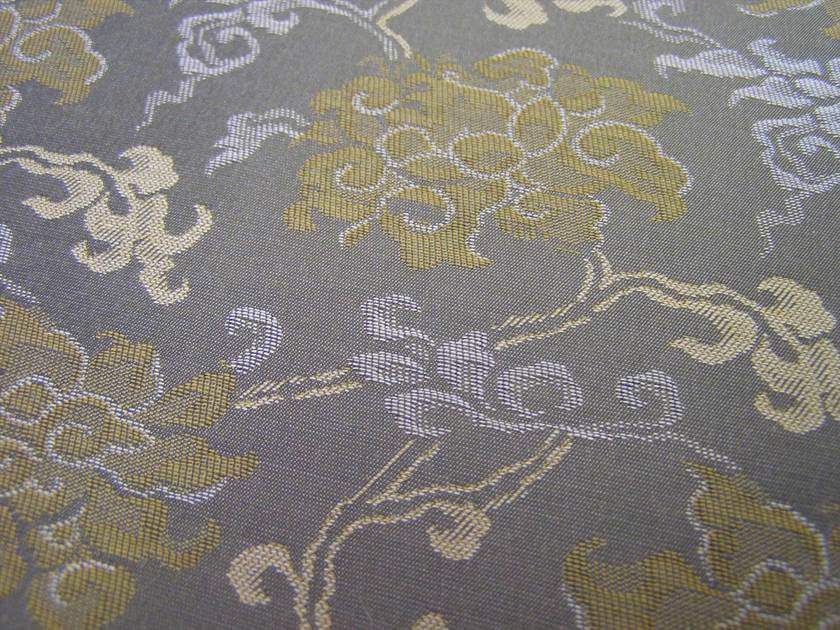
Under fluorescent light 1
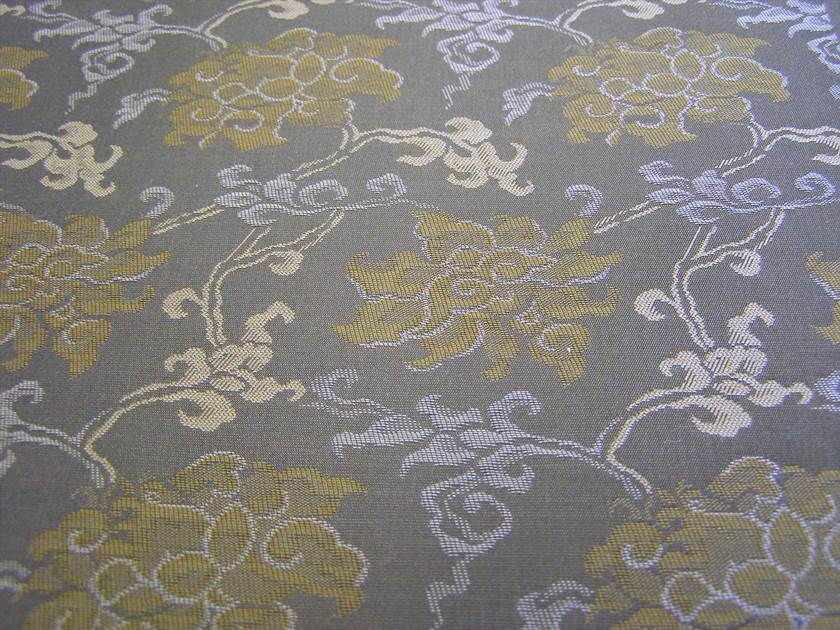
Under fluorescent light 2
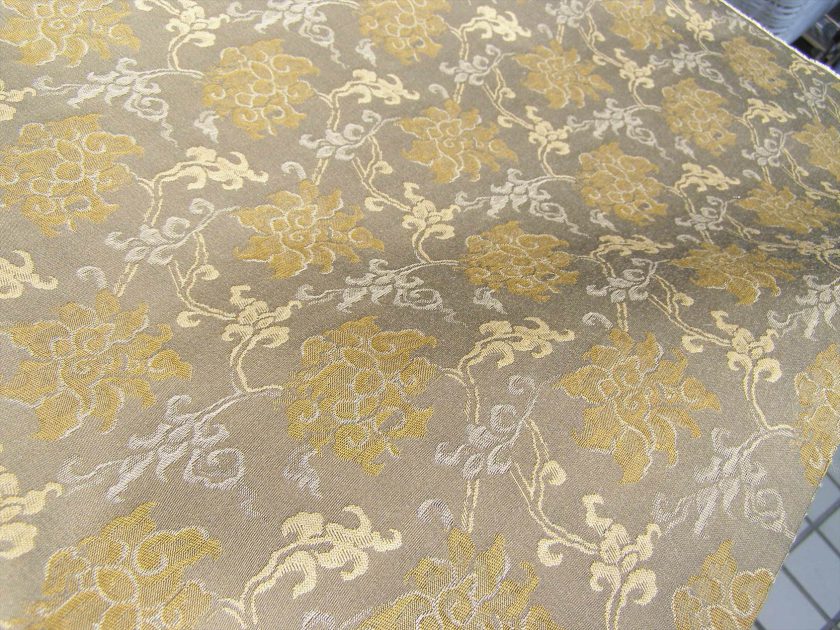
Under sunlight (outside) 1

Under sunlight (outside) 2
We received his reply;
The pictures give a very good impression of the fabric from different perspectives and all look fine to me.
Apart from fabric colors, we also suggested adding *ichimonji-otoshi as option and his reply was “yes”.
It is all settled.
※Ichimonji-otoshi :
The act of surrounding the art work with the same fabric of ichimonji. (ichimonji is a fabric attached to top and bottom of the main artwork) Ichimonji-otoshi gives a scroll sharper look.
Please refer to :
Remounting of the Nagasaki-school Tiger Hanging Scroll
+ Fabric: No. B
+ Mounting Style: Literati mounting in the manner of ichimonji-otoshi
– Smoothening wrinkles
– Additional repair and hosai of all lacking parts
– 1 plain paulownia-wood box+ Size: Maintain the original size
+ Packing: In a paulownia-wood box then in an export carton box.
Finally, remounting starts now!
Mekuri / Removal of Old Backing Paper
The kakejiku is produced through several urauchi backings. “Urauchi” is the act of applying paper to the back of paper, silk, or fabric with paste for reinforcement.
The first step in remounting kakejiku is to remove the old backing paper carefully.
Generally, there are three layers of backing paper. They are applied in the order of “hada ura-uchi”(the first), “mashi urauchi”(the second), “sou urauchi”(the final) from the back of a “honshi” main artwork. When removing the paper, we start working on with outside, “sou urauchi”(the final) in reverse order.
When it comes to degree of difficulty, the closer to a main work, the harder it becomes. Therefore, removing “hada ura-uchi”(the first backing) is the most difficult since it is directly applied to a main artwork. It is also regarded as the most difficult step in the whole repair procedure.
We focused all our attention to these points because we were afraid of these damaged parts of the painting would come off together with the backing paper. If we peel the paper back at once, it may result in further damage in case the former conservator had used strong paste. Thus, we peeled the backing paper slowly and carefully, pressing the painting gently with a tapered awl in order to prevent it from coming off.
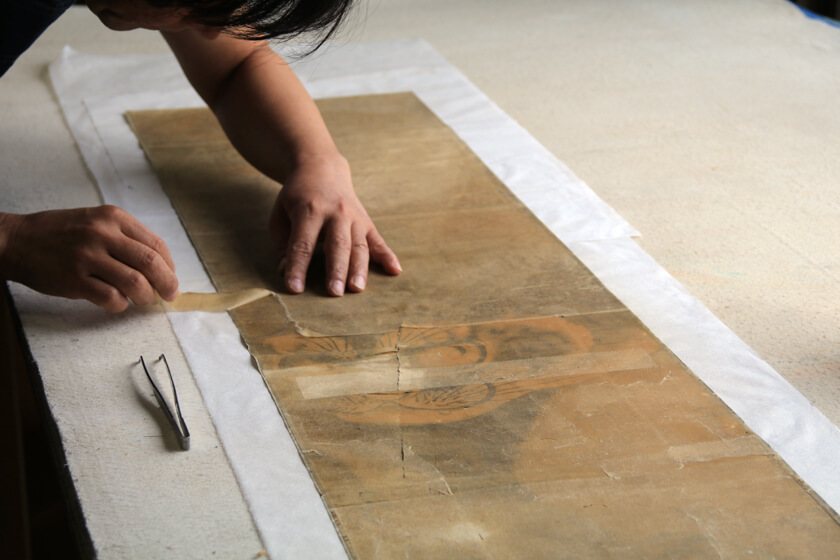
The backing paper on the back of all the lacking parts, and the big vertical slit on the tiger’s face.
As each backing paper is stripped away, the artwork reveals its true self.
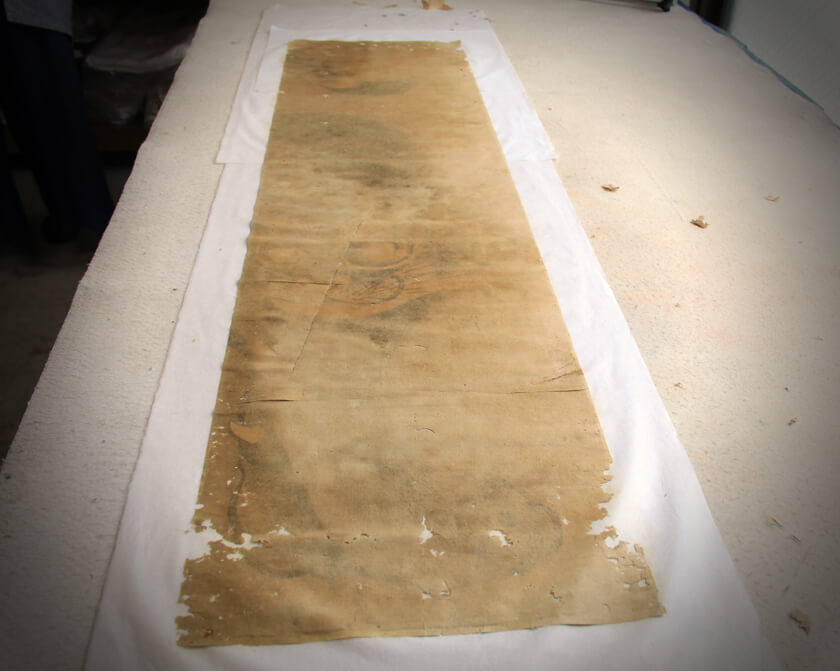
Urauchi / Backing, Karibari / Drying
The paper to be used for backing (urauchi) is selected by the craftsman (hyougushi) depending on the effect that is trying to be achieved and the condition of the main work. In mounting a “kakejiku” (hanging scroll), the first backing called “hada-urauchi,” is applied directly onto the back of the main work. In this process, relatively thin, firm paper is used.
First, apply water to the painting and stretch the wrinkles. We struggled to smooth out the slit part of the tiger’s face. If we do this with all our might, there is fear that the painting gets caught in a brush and the slit spreads even more.
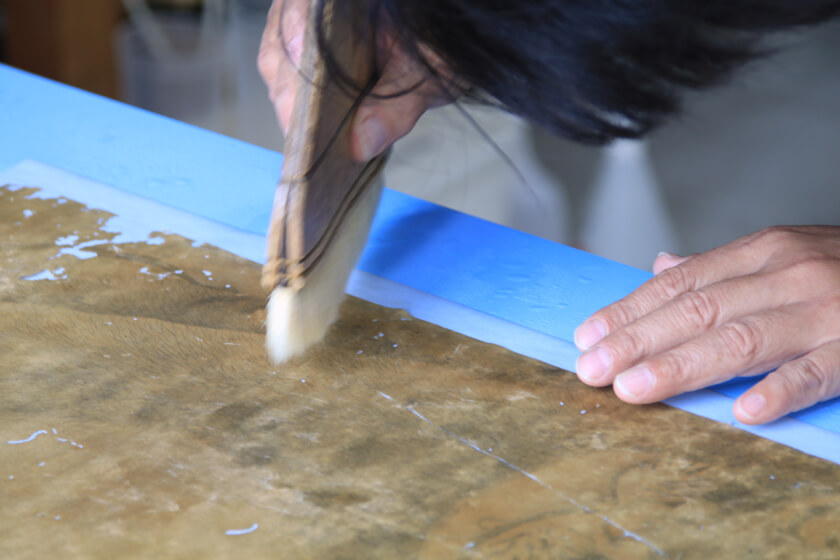
After stretching wrinkles, apply paste to a new backing paper evenly and thoroughly, making sure the paste is fully applied, or the backing paper ends up coming off later on.
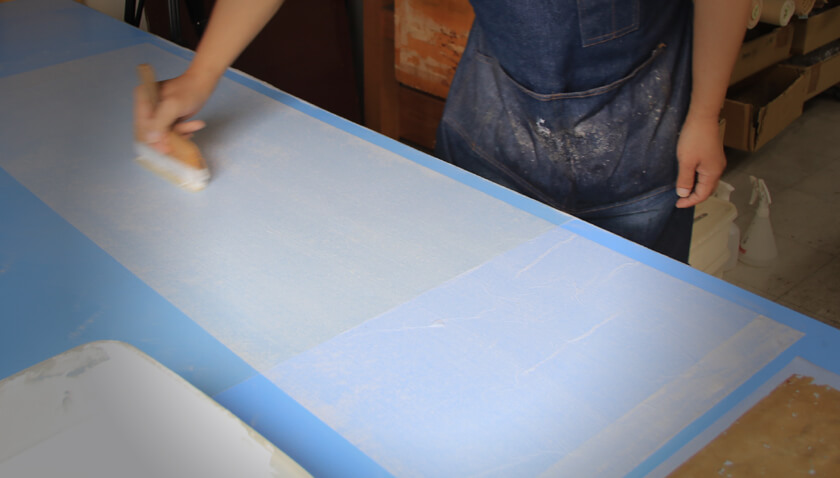
Once applying paste is finished, start mounting the backing paper onto the painting with gentle but broad strokes. Make sure to push out any air bubbles to outward since they will be the reason of wrinkles. It is not advisable to go back to the middle of procedure because the painting is likely to come off along with the backing paper once applied paste. We only have one shot for applying a backing paper or start it over so this process always makes us a little bit nervous.
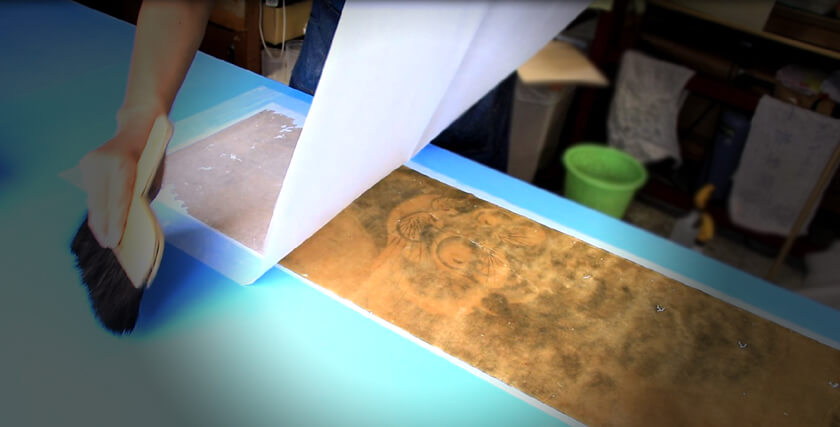
After attaching the backing paper, its surface is tapped with the brush for adhering the backing paper firmly to the main work. Keep tapping until they adhere to each other completely. This also helps to push out remained air bubbles.

During the process of the first backing, the main work will have acquired moisture and become somewhat stretched. By applying paste to the edges, and placing the main work on a “karibari” board, stress on the main work can be adjusted, and will become flat as it dries.
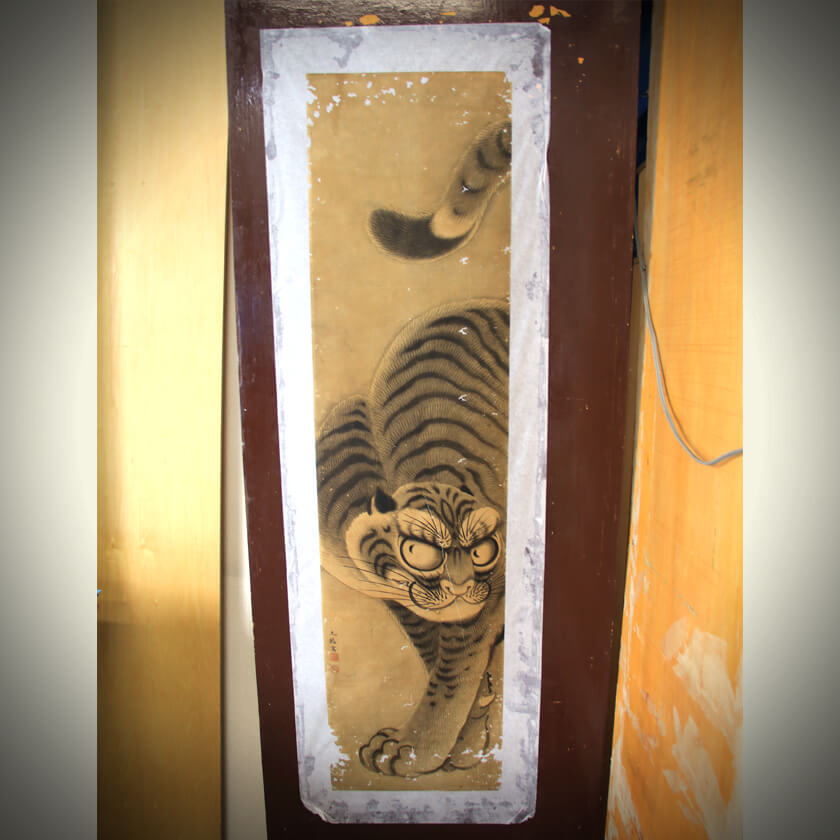
Ore-fuse / Reinforcement
The painting had countless creases and wrinkles. These areas are very brittle so they need to be reinforced in order to prevent future damage. As previously mentioned, attaching patches to the final backing paper should be avoided due to following reasons:
+ It disfigures the hanging scroll.
+ The scroll loses flexibility. Especially, the painting gets warped or distorted when hanged.
We repaired in a traditional way called ”ore-fuse”, which is to apply thin Japanese paper to the wrinkles from the back of the first (skin) backing paper.
Hosai / Toning
Hosai takes an extremely long time among all the procedure.
Add colors to the lacking parts as natural as possible.
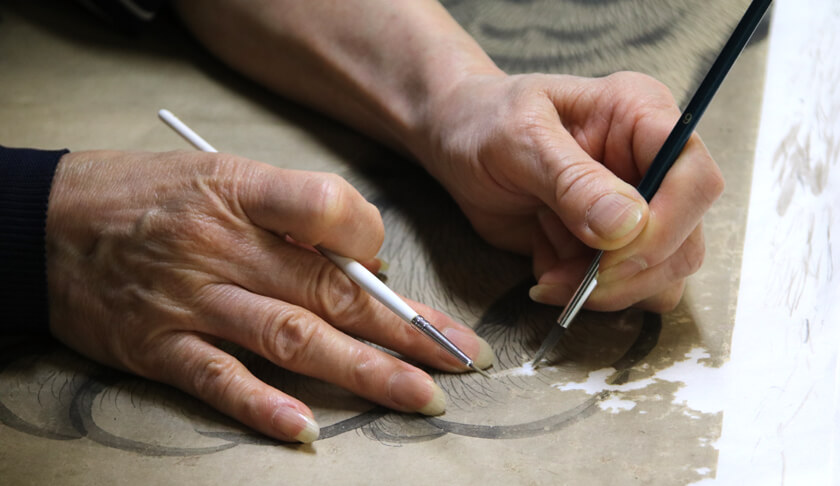
Be careful not to isolate the hosai area by adding colours little by little, using a thin pointed paintbrush and taking the overall balance into consideration. Each lacking part differs in colour so our conservator gradually proceeds hosai, confirming each color in detail. It is as if she is talking to the painting.
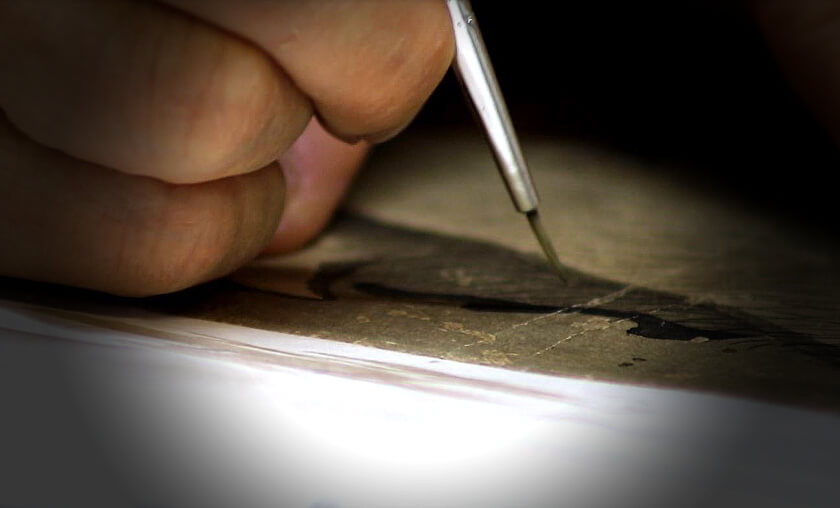
Adjusting the correct amount of water is also necessary since the first backing paper separates from the painting if the pigments are dissolved in too much water. Therefore, experience and intimate knowledge for painting, these are what counts the most in doing hosai.
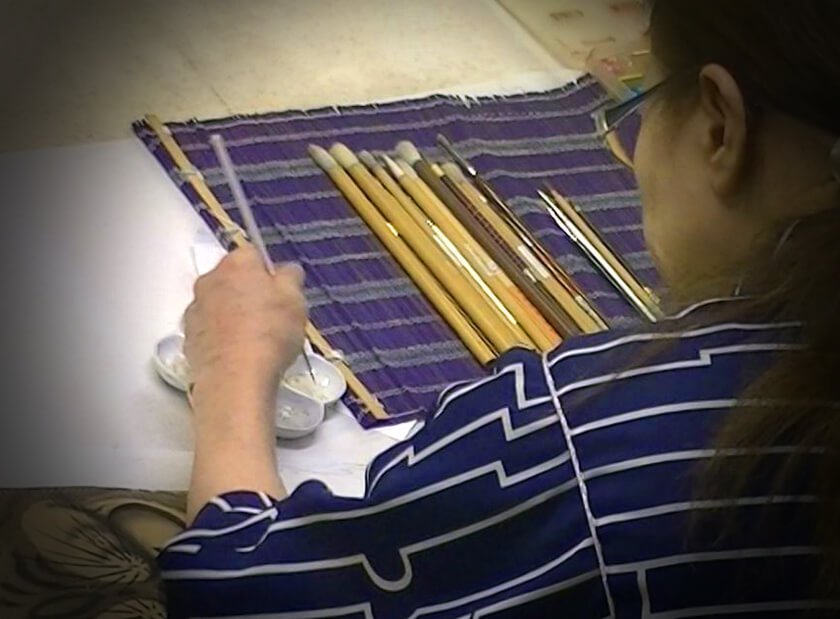
Tsukemawashi, Kiritsugi / Cut and Join
Let us move on to shaping the painting into “kakejiku”, which is to apply fabrics to the painting. All fabrics are cut into required size. They will be attached to the painting with the paste area of 3mm width. There is a knack to attaching fabrics straight.
This painting is to be completed in the manner of ichimoni-otoshi so thin lines are attached on both sides of the painting.
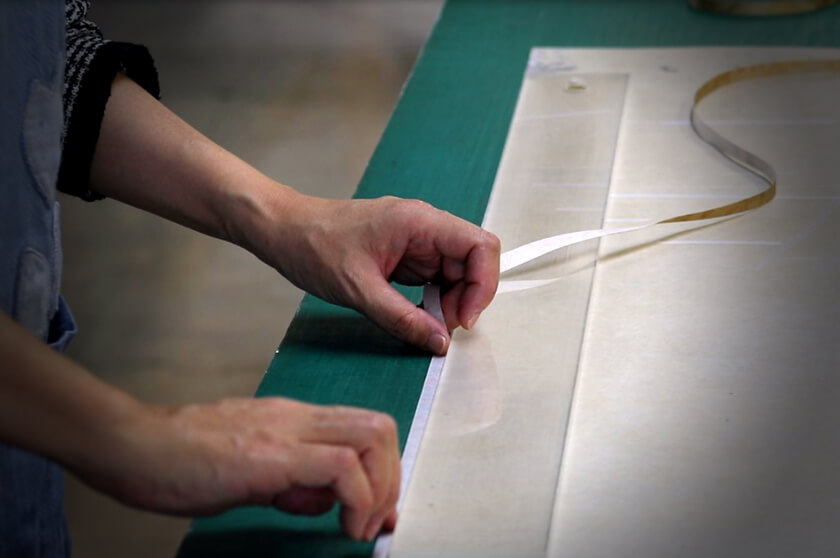
The Second Backing
The second backing is called “mashi-urauchi” (subsidiary backing of the main work and mounting fabric). It is added to maintain balance between the main work and the mounting fabric, in terms of their thickness and strength.
Tachiawase / Cutting to Size
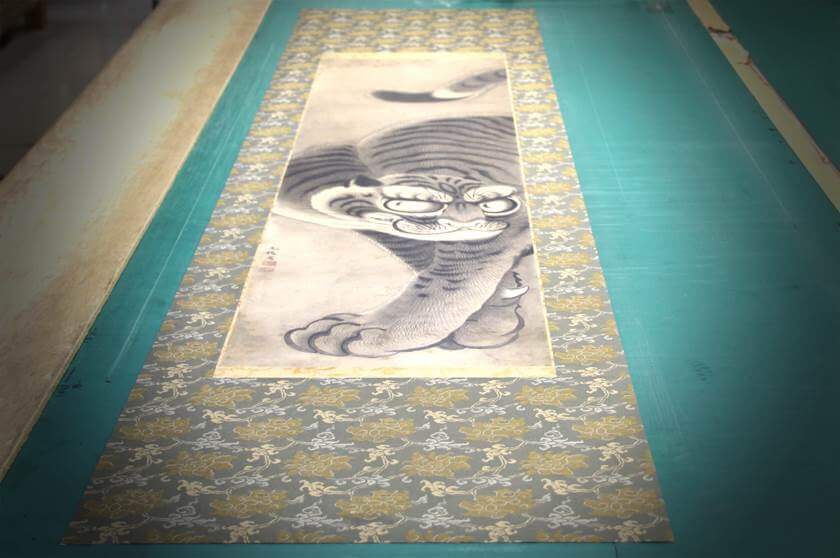
Cutting a hanging scroll to a specified size after the second backing.
Mimi-ori / Folding over the Edge
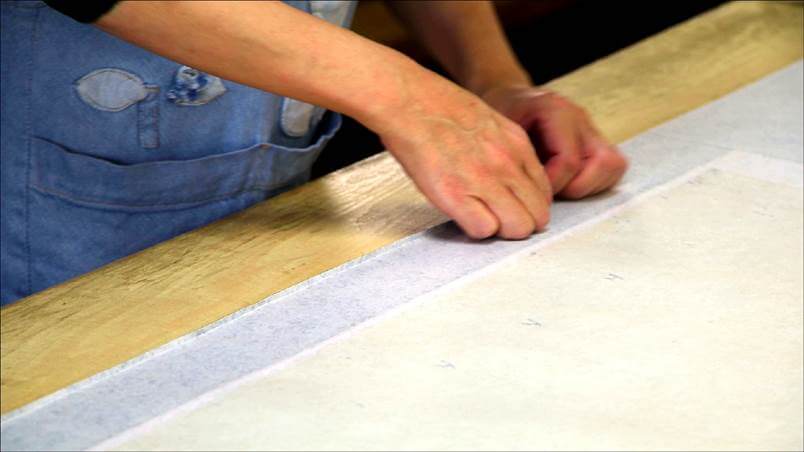
Also called “hashi-ori”. Fold the left and right edges of a hanging scroll back approximately 3 to 4.5 mm. The width differs according to the size of the hanging scroll. It is executed after cut-and-join and before the final backing.
The Final Backing
The final backing is called “sou-urauchi.” It is added to obtain a flat and smooth finish, so that the kakejiku can be rolled up smoothly.
Finishing
Attach a top rod (located in the upper part of a scroll) and a roller rod (located in the bottom). A ring tack is hammered in a top rod in order to apply two codes. One is for hanging, the other is for wrapping up a scroll. This work will be finished in a literati mounting style so it does not have fûtai (decorative fabric strips).
Remounting Completed! Here’s a New Hanging Scroll!
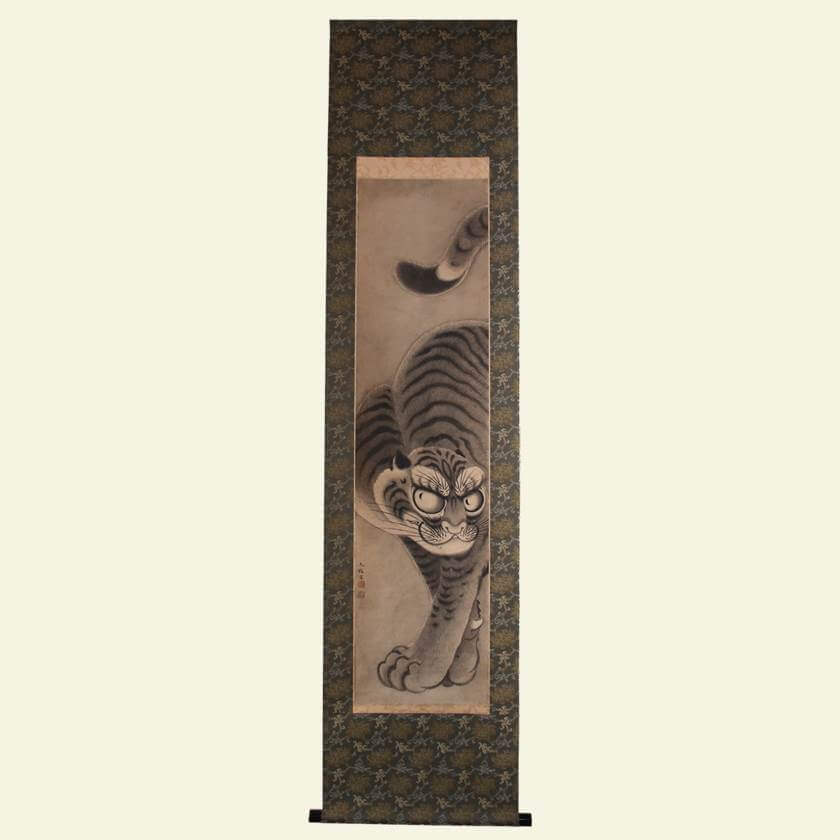
After a long restoration, the tiger’s painting is at last brought back to new life.
All staff at ART NOMURA became deeply attached to the tiger during remounting process. We were all happy that the tiger was done beautifully. Well, he has been a good-looking guy from start to finish though. Please see before and after pictures of the tiger.
Countless wrinkles were smoothed out.
A scar (vertical slit) on his face became less noticeable.
Lacking parts and moth holes were repaired.
Unattended moth holes in the former remounting became less noticeable by hosai (toning). His fur looks softer and shinier.
Adding colors to countless holes seemed endless, but it was very worthwhile.
From the side, we can clearly see the wrinkles are smoothed out.
The tiger has been restored to his new life and now looks full in vigour.
Client’s Voice
We were so grateful to receive a heartwarming message from the client :
I am deeply impressed by the sincere work that you and your team have done.
The result after hosai is very good, and also the mounting and the color of the fabrics fit perfectly to the painting.
I am really thankful to your countless efforts and skills to bring this tiger to life again! You are doing a great, wonderful job being largely responsible for the conservation of the Japanese Cultural heritage.
The next time when I am in Japan, I would love to come and visit your shop to meet and thank you and your team personally. It is such a pleasure to work with you together in my humble attempt to feature and preserve the fantastic Japanese culture heritage.
Thank you very much for recognizing our work. We feel very happy every time when we meet a client living far away from Japan and who loves and understands the charm of Japanese traditional art, kakejiku. It is so encouraging and inspiring to receive such kind compliments. It really means a lot to us. Thank you very much. We will make further efforts in providing better service.
Thank you for reading this post to the end.

